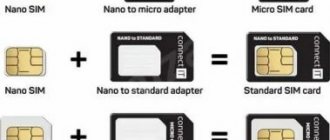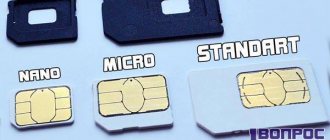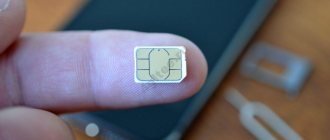The development of digital technology has always been focused on enabling people to communicate with each other without much hassle. The most important role in this direction was played by the emergence of landline phones, followed by mobile phones.
The cell phone, which gradually turned into a smartphone, has become the main device in human life. Nowadays it is difficult to imagine life without a mobile gadget that allows you to stay in touch.
And although communication has largely gone online, cellular communications still remain relevant. In addition, almost all mobile operators, along with the ability to make calls using standard telephony, offer Internet access services.
Cellular communications and the mobile network cannot work without a subscriber identification module, which is commonly called a SIM card. The first such chip appeared in the distant 90s. If you show a person a SIM card from those years now, he will be very surprised. After all, the device was the size of a credit card.
Everything changed with the advent of MiniSIM. This SIM card is remembered by all people without exception. The standard remained relevant until 2003, when a new standard, MicroSIM, was released. It didn’t stay long, because very soon it was replaced by NanoSIM, which we’ll talk about in detail today.
This standard is now considered the most popular due to its small size. Most smartphones come with slots for this type of SIM card, and users have to rack their brains to adapt their MiniSIM to the new standard.
At the same time, you should not think that the development of the chip stopped with the advent of NanoSIM. In 2014, e-SIM technology was introduced, which is based on sewing a chip into a smartphone.
e-SIM technology does not yet work in Russia, so the NanoSIM standard remains relevant for us.
| SIM card type | Year of appearance | Dimensions | Communication standards support |
| SIM | 1991 | 86x54x0.76 mm | 1G |
| MiniSIM | 1996 | 25x15x0.76 mm | 2G, 3G, 4G |
| MicroSIM | 2003 | 15x12x0.76 mm | |
| NanoSIM | 2012 | 12.3x8.8x0.67 mm | |
| e-SIM | 2014 | 6x5x0.95 mm |
What is a nano SIM card
Each owner bought a package from MTS, Megafon or TELE2 to use communication services. All owners of an iPhone model older than 4 were the first to become familiar with what a nano SIM card means. The new smartphone used a completely different card format, which was called NanoSim. The innovation was due to the fact that the iPhone had become 20% thinner and the manufacturer was looking for ways to reduce the content. The standard connector was replaced with a narrower one, and nanoSIMs began to be used instead of MicroSIM.
Residents of Moscow and other Russian cities were not ready, operators did not have time to issue new types of cards, so many needed to cut their SIM cards for a nano SIM. Old cards simply did not fit into SIM card slots (even MiniSIM and microSIM cards). All other smartphone manufacturers followed the giant's example and copied the new format to also reduce the thickness of the device.
What is a nanometer
Nano-SIM is the newest and smallest phone card available today. It looks like a chip, with virtually no plastic frame around it. Its dimensions are 12x5 mm.
Apple was the first to use such a chip for gadgets. Already owners of iPhone 5 modifications had to insert just such a card into the slot. A little later, other manufacturers adopted the experience. Now smartphones with similar slots are produced by Samsung and Meizu.
Micro SIM and nano SIM - the difference
The most important difference between a nano SIM and a micro SIM is the size and thickness. The chip also works well, there are no innovations in communication or data transmission technology, just smaller parameters made it possible to make the iPhone even thinner. Problems arose only among users who decided to switch to a new smartphone from Apple, and among operators, because the main complaints regarding the size of the SIM card were addressed to Beeline, MTS and Megafon. However, this complexity did not stop people for long, because the difference in parameters is small, for example, a micro-SIM is 12x15 mm, and a nano-SIM is 9x12 mm.
A little theory
Nano sim and micro sim are the names of the dimensional parameters of SIM cards used in any device. The dimensions of the first are much smaller compared to micro and are only 12.3 * 8.8 millimeters (for micro 15 * 12 mm). It is imperative to take this point into account when choosing a device, because a micro SIM may not fit into a port created for a different size, and vice versa.
This refers to the size of the plastic field with the chip. It itself has standard proportions - the same as those on traditional SIM cards.
How to cut a SIM card for a nano SIM
Those who had just purchased a brand new iPhone really didn’t want to wait and a pressing question arose: how to cut a micro SIM card for a nano SIM? The chip size of the SIM cards is the same, and the main problem was the amount of plastic around the edges. To reduce to nano format, you can do the following:
- perform circumcision yourself;
- take it to a workshop where the necessary tools are available;
- send it to a mobile phone store and request a replacement card.
How to make a nano sim from a micro sim
If you don’t want to travel or go anywhere, you can try to reduce the size of the SIM card yourself. There is a proven way to cut a micro SIM card under a nano SIM if you have a printer, scissors and double-sided adhesive paper. It should be remembered that during trimming there is a possibility of getting a non-working SIM card from a working SIM card. You perform all actions at your own peril and risk. You will need:
- double-sided tape (you can use glue, but this option is worse;
- micro or standard SIM card;
- printer and paper;
- ruler;
- pencil;
- scissors (or nail clippers);
- sandpaper.
The rules for pruning will not differ depending on the gadget, for an Apple phone or tablet. In order not to cut off extra millimeters and not damage the circuit, you will need a nano format SIM card template, which can be easily downloaded. Next you need to do the following.
- Print the downloaded template; there is no need to change the scale or location of the drawing. You don't need color printing, regular black and white will suffice. It is important that the drawing is simply clear.
- Using scissors, cut the template to the size that fits your card. Inside the picture, the parameters for the nano-SIM card will be indicated.
- Glue it with tape/glue to the side of the SIM card on which the operator’s logo is written (the chip should not be exposed to any impact). Focus on the cut corner of the drawing, which will prevent you from making a mistake with the correct sides.
- Wait for the glue to dry (not required in the case of tape), and carefully cut off the excess plastic along the lines of the template. If the scissors are not sharp enough, use nail clippers.
- Remove the glued paper from the SIM card.
Don’t worry that the cut lines will pass in close proximity to the chip; this will not affect the performance of the micro-SIM in any way unless you deliberately touch it. Use sandpaper to round the edges and sand down any rough edges on the plastic. If the card is difficult to fit on one side, sharpen it a little more with sandpaper.
How to make a nano sim from a regular one
The exact same method that was described above is suitable if you have a question about how to make a nano SIM from a regular SIM card. Please note that older card models have a larger chip, so you will have to remove almost all the plastic around the circuit. Residues should be removed carefully with sandpaper or a nail file. Another subtlety of old SIM card models is thickness. The new format has become not only small, but also thin, so in addition to the four sides, you will have to sharpen the back side, where you have Megafon or MTS written on it.
Another option is to buy a special device from an online store that cuts the card to the required size. It looks outwardly like a stapler; a regular SIM is placed inside, the handles are carefully pressed, and all excess is cut off in one click. The tool can cut Micro or Nano format. Exactly the same devices are used in the communications and mobile departments. The tool is inexpensive, but there is no point in buying it just to reduce 1 card.
- Fitness for pregnant women by trimester. Is it possible for pregnant women to play sports and gymnastics at home?
- How to get a loan with bad credit history and arrears
- Eyebrow microblading - what is it?
Micro-SIM
Despite all the convenience of the previous model, the new generation of SIM cards did not take long to arrive. Just 7 years later, in 2003, a new SIM card was introduced to the world - micro
. New cards were released according to the ETSI standard, Mini-UICC format. As you can easily guess from the name, one of the main differences of the new card was its size, 15 by 12 mm. The SIM card became almost square, and from that moment on its serial code began to be stamped close to the microchip, thereby saving a lot of space. According to the developers, this model was originally created for special miniature mobile devices whose dimensions could not accommodate a mini card. However, over time, mini SIM cards became the main form due to advanced functionality, including:
- Support for multi-stream communication channel. The essence of this function is that information from the telecom operator will be transmitted in simultaneous streams through virtual channels, significantly increasing the speed of information transfer, in comparison with the previous model, which transmits data sequentially.
- Improved security features thanks to a system of mutual authentication of the SIM card and the cell from which the connection is made. This made it possible to eliminate the theft of subscriber IP addresses, unauthorized entry into secure networks, and IP address spoofing to steal subscriber personal data.
- A new, hierarchical PIN system that assigns a unique PIN to apps and adds a local code. This feature also increased the security of the subscriber’s personal data, preventing attackers from gaining full control of the device. The previous model used a universal PIN code system, allowing the owner of the code to gain full access to any information.
- A significant increase in the memory capacity of the SIM card, which allows you to not only store more contacts and messages, but also add other information, such as second names of subscribers or even their email addresses.
Where to change a regular SIM card to a nano one
If you don’t risk cutting your standard SIM, it’s better to exchange it for free for a new option from your operator. This is the only sure way to get a nano SIM with your number. Operators offer you to change to another card. All you need to do is come to the post office and take with you:
- passport;
- contract;
- old map.
Conclusion
We looked at what the new format cards are. If the old card is not the right size for use in the new phone, exchange it for a new one or cut it yourself. Reduce size carefully. If the chip is damaged, the card cannot be restored.
Sources
- https://www.iphones.ru/iNotes/sekrety-sim-karty-o-kotoryh-vy-ne-znali-06-16-2019
- https://RuBrowsers.ru/uncategorized/sim-karta
- https://4gltee.ru/mikro-sim-i-nano-sim-raznitca/
- https://SmartPhonus.com/%D0%B2%D0%B8%D0%B4%D1%8B-%D0%B8-%D1%80%D0%B0%D0%B7%D0%BC%D0%B5 %D1%80%D1%8B-sim-%D0%BA%D0%B0%D1%80%D1%82-%D1%81%D0%BC%D0%B0%D1%80%D1%82%D1 %84%D0%BE%D0%BD%D0%BE%D0%B2/
- https://protabletpc.ru/advice/kak-obrezat-sim-kartu.html
- https://SetPhone.ru/stati/vidy-sim-kart-razmery-obrezka/
- https://PoiskTehniki.ru/smartfony/viborsmartphones/nano-sim-i-micro-sim-v-chem-raznica
- https://sravnismart.ru/sim_card_slot/
- https://SmartPhonus.com/nano-sim-%D1%87%D1%82%D0%BE-%D1%8D%D1%82%D0%BE-%D1%82%D0%B0%D0%BA %D0%BE%D0%B5/
- https://geek-nose.com/nano-sim-i-microsim/
- https://public-pc.com/chto-takoe-nano-sim-karta/
- https://besprovodnik.ru/nano-sim/
- https://konekto.ru/nano-sim-karta-chto-jeto-takoe.html
- https://KakOperator.ru/lifehacks/chto-takoe-nano-sim-karta
- https://xiaomium.ru/vidy-razmery-sim-kart-smartfonah
Where to cut a SIM card
If you decide that you don’t want to do anything yourself to avoid damage, then there are two options for cutting the SIM card. You can come to a communication store, they will offer you either to completely replace the plastic, get a new SIM, which has several layers and can be squeezed out of the shell to the required format. Or the employee will use the “stapler” described above. The second option is to go to your nearest phone repair shop. Each of these departments also has a stapler; for a nominal price (and in some places even free) they will cut off the excess plastic for you.
Nano SIM card price
If you contact a mobile phone store, the exchange will be carried out absolutely free of charge. Now this takes just a few minutes. And within a day, your old plastic will stop functioning completely. If you go to a workshop or hardware store, you should know how much it costs to cut a SIM card. As a rule, the cost of the service ranges in large cities from 100 to 300 rubles. The price may be lower, and some kind craftsmen do it for free.
Find out about ways to switch to another MTS tariff.











